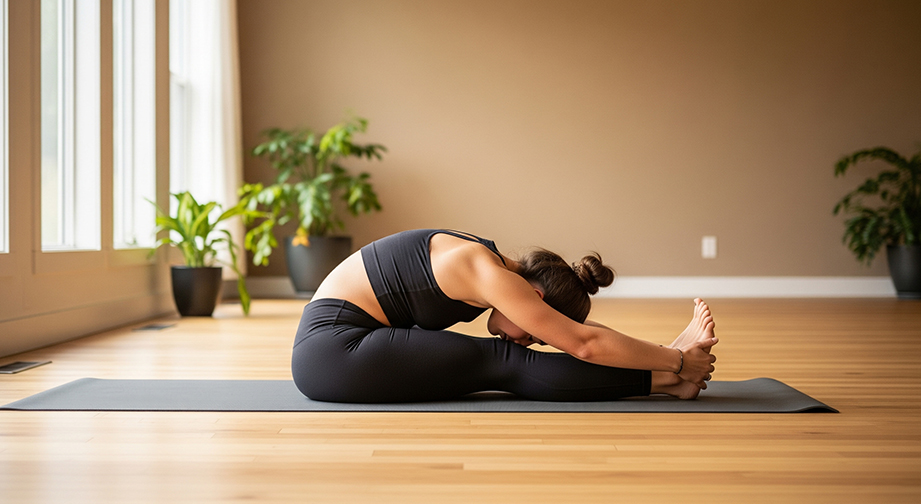Paschimottanasana (Seated Forward Bend): Your Gentle Guide
Introduction
Paschimottanasana (pronounced PASH-ee-moh-tan-AHS-uh-nuh), or Seated Forward Bend, is a calming yoga asana that stretches your entire back body from head to heels. The Sanskrit word “Paschima” means “west” (symbolizing the back of the body), and “uttana” means “intense stretch.” At its essence, Paschimottanasana soothes the nerves and gently relieves stress.
If you’ve ever felt stiff or tight after sitting too long at your desk or just need a way to unwind, this pose is your best friend for melting away tension in the back and hamstrings.
Step-by-Step Guide

- Sit down with your legs stretched out in front, feet together and flexed (toes pointing upward). Sit upright on your sitting bones.
- Inhale and stretch your arms overhead, lengthening your spine and reaching up through your fingertips.
- Exhale slowly as you hinge from your hips, not your waist, and begin to fold forward over your legs. Keep your back as long as possible.
- Hold your feet, ankles, or shins—wherever your hands can reach comfortably—without forcing or rounding your back.
- With each inhale, lengthen the spine forward.
- With each exhale, gently deepen the fold, keeping chest open and neck relaxed.
- Stay here for 5 to 10 breaths (around 30 seconds to 1 minute). Beginners can do 2–3 rounds, holding as long as comfortable.
- Modifications for Beginners: Sit on a folded blanket or use a yoga strap looped around your feet to help you come forward with a straight spine.
- For Advanced Practitioners: Deepen the fold by grasping the soles or clasping wrists beyond your feet, aiming to bring chest and belly closer to the thighs.
Alignment & Safety Tips
- Key Alignment: Hinge at the hips (not waist); keep spine extended, shoulders relaxed, and knees pointing up.
- Common Mistakes: Rounding your back, locking knees, pulling forcefully with hands—avoid these by moving gently and respecting your limits.
- Safety: If you have back or hamstring injuries, avoid deep bending. Pregnant women, or those with asthma or diarrhea, should not practice this pose. Stop if you feel pain or pinching.
Benefits of Paschimottanasana
Physical Benefits:
- Stretches hamstrings, calves, and back muscles.
- Improves posture and spinal flexibility.
- Stimulates digestive organs and supports gut health.
- Relieves mild back aches and menstrual discomfort.
Mental Benefits:
- Promotes relaxation and stress relief.
- Calms the mind and reduces anxiety.
- Encourages mindfulness and introspection.
Energy & Chakra Connection:
- Balances the Manipura (Solar Plexus) Chakra, which governs personal power and digestion.
- Grounds energy and promotes a sense of inward focus.
Contraindications
- Avoid if you have a herniated disc, recent back or hamstring injury, severe spinal conditions, or during late pregnancy.
- People with asthma or diarrhea should skip this pose.
- Alternative: Try Sukhasana Forward Fold (seated easy pose with forward bend) or practice Supta Padangusthasana (reclining hand-to-big-toe pose) with a strap.
Beginner’s Tips & Variations
- Use a yoga strap around feet to gently draw yourself forward while keeping your spine long.
- Sit atop a folded blanket or bolster to tilt pelvis forward, making the fold easier.
- If your hamstrings are very tight, bend knees slightly and gradually work toward straightening them.
- Advancements: For a deeper stretch, grasp beyond your feet or bind your arms around your feet.
How to Include Paschimottanasana in a Yoga Flow
- Best practiced as a cool-down or in the main sequence after warming up the legs.
- Pairs beautifully with:
- Janu Sirsasana (Head-to-Knee Pose)
- Uttanasana (Standing Forward Bend)
- Ardha Matsyendrasana (Seated Spinal Twist)
Mind-Body Connection
Paschimottanasana is as much a practice in patience as in flexibility. With every exhalation, allow your mind and body to surrender a little more, drawing inward, cultivating calm, and fostering self-acceptance. Energetically, it awakens your Solar Plexus Chakra, enhancing confidence and inner strength.
Asana Name: Seated Forward Bend (Paschimottanasana)
Level: Beginner–Intermediate
Focus Areas: Hamstrings, spine, back, calves
Duration: 30 seconds to 2 minutes
Best Time to Practice: Morning or Evening (when the body is warmer)
FAQs on Paschimottanasana (Seated Forward Bend)
Q: Is Paschimottanasana safe for beginners?
Yes! Use props like a strap or bolster, and keep knees bent if needed. Move gently and avoid forcing the stretch.
Q: What should I do if I feel pain in my lower back?
Back out of the pose, try sitting up on a blanket, or keep knees bent. Never force into pain—mild discomfort is okay, pain is not.
Q: How often should I practice Paschimottanasana?
Daily or several times a week for best results. Always listen to your body and adjust as needed.